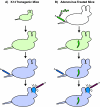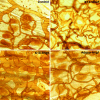Complementary actions of VEGF and angiopoietin-1 on blood vessel growth and leakage
- PMID: 12162725
- PMCID: PMC1570748
- DOI: 10.1046/j.1469-7580.2002.00061.x
Complementary actions of VEGF and angiopoietin-1 on blood vessel growth and leakage
Abstract
Vascular endothelial growth factor (VEGF) and Angiopoietins are families of vascular-specific growth factors that regulate blood vessel growth, maturation and function. To learn more about the effects of these factors in vivo, we have overexpressed VEGF-A or Angiopoietin-1 (Ang1) in two systems in mice, and examined the effects on blood vessel growth and function. In one set of studies, VEGF, Ang1, or both factors, were transgenically overexpressed in the skin under the keratin-14 (K14) promoter. The skin of mice overexpressing VEGF (K14-VEGF) had numerous tortuous, capillary-sized vessels which were leaky to the plasma tracer Evans blue under baseline conditions. In contrast, the skin of mice overexpressing Ang1 (K14-Ang1) had enlarged dermal vessels without a significant increase in vessel number. These enlarged vessels were less leaky than those of wild-type mice in response to inflammatory stimuli. In double transgenic mice overexpressing VEGF and Ang1, the size and number of skin vessels were both increased; however, the vessels were not leaky. In a second set of studies, VEGF or Ang1 was systemically delivered using an adenoviral approach. Intravenous injection of adenovirus encoding VEGF (Adeno-VEGF) resulted in widespread tissue oedema within 1-2 days after administration, whereas injection of Adeno-Ang1 resulted in the skin vessels becoming less leaky in response to topical inflammatory stimuli or local injection of VEGF. The decreased leakage was not accompanied by morphological changes. Thus, overexpressing VEGF appears to promote growth of new vessels accompanied by plasma leakage, whereas overexpressing Ang1 promotes the enlargement of existing vessels and a resistance to leakage. Further understanding of the interrelationship of these factors during normal development could lead to their application in the treatment of ischaemic diseases.
Figures


References
-
- Baumgartner I, Pieczek A, Manor O, Blair R, Kearney M, Walsh K, et al. Constitutive expression of phVEGF165 after intramuscular gene transfer promotes collateral vessel development in patients with criticallimb ischemia. Circulation. 1998;97:1114–1123. - PubMed
-
- Carmeliet P, Ferreira V, Breier G, Pollefeyt S, Kieckens L, Gertsenstein M, et al. Abnormal blood vessel development and lethality in embryos lacking a single VEGF allele. Nature. 1996;380:435–439. - PubMed
-
- Davis S, Aldrich TH, Jones PF, Acheson A, Compton DL, Jain V, et al. Isolation of angiopoietin-1, a ligand for the TIE2 receptor, by secretion-trap expression cloning. Cell. 1996;87:1161–1169. - PubMed
-
- Detmar M, Brown LF, Schon MP, Elicker BM, Velasco P, Richard L, et al. Increased microvascular density and enhanced leukocyte rolling and adhesion in the skin of VEGF transgenic mice. J. Invest. Dermatol. 1998;111:1–6. - PubMed
-
- Dumont DJ, Gradwohl G, Fong GH, Puri MC, Gertsenstein M, Auerbach A, et al. Dominant-negative and targeted null mutations in the endothelial receptor tyrosine kinase, tek, reveal a critical role in vasculogenesis of the embryo. Genes Dev. 1994;8:1897–1909. - PubMed
Publication types
MeSH terms
Substances
LinkOut - more resources
Full Text Sources
Other Literature Sources
Miscellaneous

